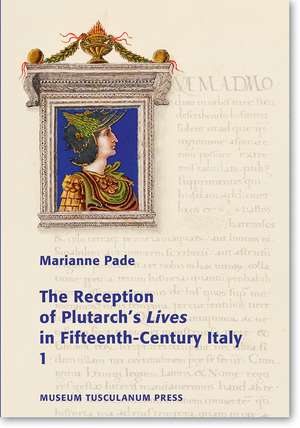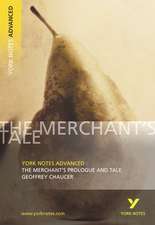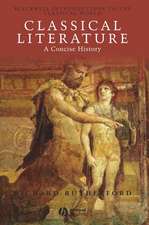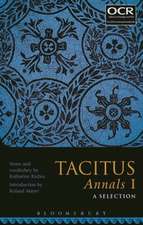The Reception of Plutarch's Lives in Fifteenth-Century Italy
Autor Marianne Padeen Limba Engleză Hardback – 19 mai 2007
Plutarch's Lives of great Greek and Roman public figures are among the central texts of European culture. Like most Greek authors Plutarch had been virtually unknown in Western Europe during the Middle Ages, but when Renaissance humanists rekindled interest in Greek language and culture, he became one of the most widely read authors of the period. Marianne Pade discusses the many Latin translations of the Lives produced during the fifteenth century, examines their diffusion in manuscripts and printed books and shows how Plutarch came to influence fifteenth-century Italian culture. The overwhelming interest in the Lives can be explained by studying the way Classical Antiquity was used for ideological purposes in Renaissance Italy. To a great extent the historical effects of the biographies reflect the ideologies of the environments in which they were translated and read. The purpose of the biographies, and often of the forewords of the translations as well, was to evoke or create a city's national myths or to promote a patron or the city itself. The second volume contains an edition of all the letters of dedication and a catalogue of the preserved manuscripts.
Preț: 524.49 lei
Preț vechi: 654.07 lei
-20% Nou
Puncte Express: 787
Preț estimativ în valută:
100.36€ • 104.58$ • 83.10£
100.36€ • 104.58$ • 83.10£
Carte disponibilă
Livrare economică 13-27 martie
Preluare comenzi: 021 569.72.76
Specificații
ISBN-13: 9788763505321
ISBN-10: 8763505320
Pagini: 754
Ilustrații: 2 volume set
Dimensiuni: 191 x 241 x 58 mm
Greutate: 1.94 kg
Editura: Museum Tusculanum Press
Colecția Museum Tusculanum Press
ISBN-10: 8763505320
Pagini: 754
Ilustrații: 2 volume set
Dimensiuni: 191 x 241 x 58 mm
Greutate: 1.94 kg
Editura: Museum Tusculanum Press
Colecția Museum Tusculanum Press
Recenzii
...there never has been a comparable effort at a comprehensive survey, and many points of detail, especially pertaining to dates, are reassessed and corrected here. On the whole this is an impressive piece of meticulous scolarship, and vol. ii contains a great amount of raw material that can be utilized. The two volumes are beautifully produced with some eye-catching illustrations; there are but a few trivial misprints and virtually no mistakes in the text. Plutarch would have loved this book.- Joseph Geiger, Scripta Classica Israelica Vol. XXVII, 2008.
... Pade's study is a substantial contribution to the study of fifteenth-century Italian humanism. The transcriptions and indices of her second volume also provide resource for other scholars. The book is beautifully produced and generously illustrated.- Julia Haig Gaisser, Renaissance Quarterly, spring 2008.
This is the sort of work that could not have been achieved under the tyranny of the British Research Assessment Exercise. When I was a graduate student, Marianne Pade was pointed out to me as the scholar hard at work cataloguing all the humanist translations of Plutarch’s Lives. My receding hairline tells me that was more than a dozen years ago. In the meantime, her many articles have given witness to the progress of her work; the republic of letters has been patiently expectant of the final product. It was worth the wait. ...What she has produced is a monumental and definitive two-volume work. Its closest parallel is James Hankins’s 1990 Plato in the Italian Renaissance, a work alongside which it will not blush to stand on bookshelves. Like that, it is a work of meticulous research demonstrated by the listing of manuscripts and the editions of prefaces that occupy the second tome. In the first, Pade reveals her impressive grasp of the bibliography of her subject, and her mastery of the evidence she marshalls. ...While there will, naturally, be debates around some of the interpretation, what will make this work a monument more lasting than bronze is its status as a treasure-trove of knowledge. ...In short, these volumes will surely attain the long shelf-life they deserve – much longer, one suspects, than many works rushed into print under the RAE regime.- David Rundle, Renaissance Studies, Vol. 23, 1, 2008.
Those interested in the Classical tradition in the Renaissance are fortunate to have available this voluminous and well-edited monograph by Professor Marianne Pade, who for almost twenty years has regularly published other articles on the topic. Although her work is clearly grounded in a particular place and time (Italy from ca.1400 to ca.1460 AD), Professor Pade provides a succinct and accurate background for the nonspecialist reader (1:37-87), explaining the tradition and influence of Plutarch in the Greco-Roman imperial world, in Byzantium, and in the Christian West up to the fourteenth century (above all with the mysterious Institutio Traiani, which has been a controversial topic for scholars). ...The two volumes are a great source of information to those interested in Plutarch's tradition and translation of his texts in the fifteenth century, not only in Italy but in other countries as well, to the same level in which humanism appeared in countries such as Spain, France, etc. ...In conclusion, the book is an excellent work and an opportunity to reflect one more time on the extraordinary role played in the history of European culture by the translator ...- Jorge Bergua Cavero, Sixteenth Century Journal XXXIX/4 (2008).
Notă biografică
Marianne Pade is professor of Classical Philology at Aarhus University.
Cuprins
Volume 1
Acknowledgements
Introduction
Part I: Text
1. The reception of Plutarch in the Roman Empire and in Greek literature down to the thirteenth century
2. The revival of interest in Plutarch in the Latin West
3. Florence and Florentine humanism 1390–1414
4. Venice 1414–1440s: Venice as heir to the Greek city states and “patrician humanism”
5. Northern Italy: other translations
6. Guarino at Ferrara in the 1430s
7. Florence and the Roman Curia in the 1430s and ‘40s
8. The remaining Lives
9. Conclusion
10. Appendix I: Texts relating to Guarino
11. Appendix 2: Lapo’s prefaces to Humphrey of Gloucester and Alfonso of Aragon 1437–38
12. Printed editions
List of illustrations
Volume 2
Part II: Prefaces, List of Translations
1. Theseus and Romulus
2. Lycurgus and Numa
3. Solon and Publicola
4. Coriolanus and Alcibiades
5. Themistocles and Camillus
6. Pericles and Fabius Maximus
7. Pelopidas and Marcellus
8. Philopoemen and Flamininus
9. Aristides and Cato Major
10. Timoleon and Aemilius Paulus
11. Agis et Cleomenes and Gracchi
12. Lysander and Sulla
13. Pyrrhus and Marius
14. Sertorius and Eumenes
15. Cimon and Lucullus
16. Nicias and Crassus
17. Agesilaus and Pompeius
18. Alexander and Caesar
19. Phocion and Cato minor
20. Dion and Brutus
21. Demosthenes and Cicero
22. Demetrius and Antonius
23. Artaxerxes
24. Aratus
25. Galba and Otho
Part III: Catalogues
List of Manuscripts Containing Latin Translations of Plutarch’s Lives and related texts
List of Scribes
List of Owners
List of Dated or Datable Manuscripts
Bibliography
Index of Manuscripts and Incunables
Index of Names
Acknowledgements
Introduction
Part I: Text
1. The reception of Plutarch in the Roman Empire and in Greek literature down to the thirteenth century
2. The revival of interest in Plutarch in the Latin West
3. Florence and Florentine humanism 1390–1414
4. Venice 1414–1440s: Venice as heir to the Greek city states and “patrician humanism”
5. Northern Italy: other translations
6. Guarino at Ferrara in the 1430s
7. Florence and the Roman Curia in the 1430s and ‘40s
8. The remaining Lives
9. Conclusion
10. Appendix I: Texts relating to Guarino
11. Appendix 2: Lapo’s prefaces to Humphrey of Gloucester and Alfonso of Aragon 1437–38
12. Printed editions
List of illustrations
Volume 2
Part II: Prefaces, List of Translations
1. Theseus and Romulus
2. Lycurgus and Numa
3. Solon and Publicola
4. Coriolanus and Alcibiades
5. Themistocles and Camillus
6. Pericles and Fabius Maximus
7. Pelopidas and Marcellus
8. Philopoemen and Flamininus
9. Aristides and Cato Major
10. Timoleon and Aemilius Paulus
11. Agis et Cleomenes and Gracchi
12. Lysander and Sulla
13. Pyrrhus and Marius
14. Sertorius and Eumenes
15. Cimon and Lucullus
16. Nicias and Crassus
17. Agesilaus and Pompeius
18. Alexander and Caesar
19. Phocion and Cato minor
20. Dion and Brutus
21. Demosthenes and Cicero
22. Demetrius and Antonius
23. Artaxerxes
24. Aratus
25. Galba and Otho
Part III: Catalogues
List of Manuscripts Containing Latin Translations of Plutarch’s Lives and related texts
List of Scribes
List of Owners
List of Dated or Datable Manuscripts
Bibliography
Index of Manuscripts and Incunables
Index of Names















